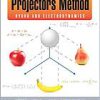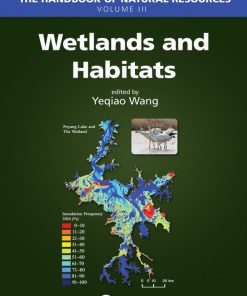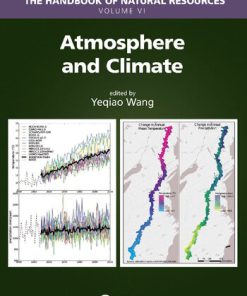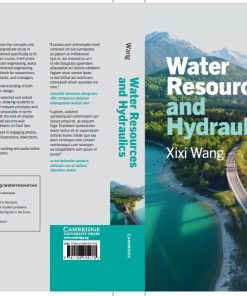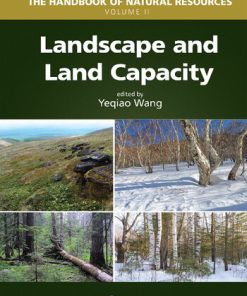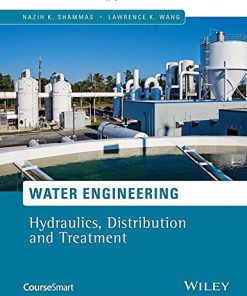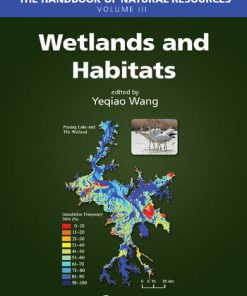Fresh Water and Watersheds 2nd Edition by Yeqiao Wang ISBN 0429804849 9780429804847
$50.00 Original price was: $50.00.$25.00Current price is: $25.00.
Fresh Water and Watersheds 2nd Edition by Yeqiao Wang – Ebook PDF Instant Download/Delivery: 0429804849, 978- 0429804847
Full download Fresh Water and Watersheds 2nd Edition after payment
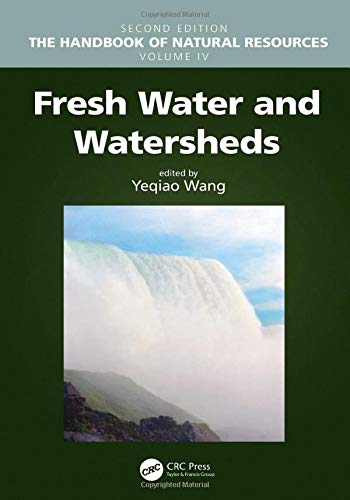
Product details:
ISBN 10: 0429804849
ISBN 13: 978-0429804847
Author: Yeqiao Wang
Authored by world-class scientists and scholars, The Handbook of Natural Resources, Second Edition, is an excellent reference for understanding the consequences of changing natural resources to the degradation of ecological integrity and the sustainability of life. Based on the content of the bestselling and CHOICE-awarded Encyclopedia of Natural Resources, this new edition demonstrates the major challenges that the society is facing for the sustainability of all well-being on the planet Earth. The experience, evidence, methods, and models used in studying natural resources are presented in six stand-alone volumes, arranged along the main systems of land, water, and air. It reviews state-of-the-art knowledge, highlights advances made in different areas, and provides guidance for the appropriate use of remote sensing and geospatial data with field-based measurements in the study of natural resources.
Volume 4, Fresh Water and Watersheds, covers fresh water and watersheds, their health and conservation, protection, and management. Organized for ease of reference, it provides fundamental information on groundwater storage, water quality, supply and balance, and water resource vulnerability. New in this edition are discussions on water footprint assessment, water surface dynamics, and water management on a global scale. Understanding the conditions of watersheds is crucial for restoring areas with degraded water quality as well as protecting healthy waters from emerging problems. This volume demonstrates the key processes, methods, and models used through several practical case studies from around the world.
Written in an easy-to-reference manner, The Handbook of Natural Resources, Second Edition, as individual volumes or as a complete set, is an essential reading for anyone looking for a deeper understanding of the science and management of natural resources. Public and private libraries, educational and research institutions, scientists, scholars, and resource managers will benefit enormously from this set. Individual volumes and chapters can also be used in a wide variety of both graduate and undergraduate courses in environmental science and natural science at different levels and disciplines, such as biology, geography, earth system science, and ecology.
Fresh Water and Watersheds 2nd Table of contents:
Section I: Fresh Water and Hydrology
1. Aquifers: Groundwater Storage
- Introduction
- Compressibility
- Confined Aquifer Storage
- Unconfined Aquifer Storage
- Confining Units
- Three-Dimensional Storage
- Conclusion
- References
- Bibliography
2. Aquifers: Recharge
- Introduction
- Water Budget Methods
- Methods Based on Surface Water or Ground Water Data
- Darcian Methods
- Tracer Methods
- Other Methods
- References
3. Artificial Reservoirs: Land Cover Change on Local Climate
- Introduction
- Is the Impact of Dams Detectable from Observational Records?
- Conclusion
- Acknowledgments
- References
4. Drainage and Water Quality
- Environmental Conditions
- Pollutant Properties
- Management Practices
- Conclusion
- References
5. Endorheic Lake Dynamics: Remote Sensing
- Introduction
- Global Distribution of Endorheic Lakes
- Remote Sensing Monitoring of Endorheic Lakes
- Conclusion
- Acknowledgments
- References
6. Eutrophication
- Introduction
- Cultural Eutrophication
- Rate of Eutrophication
- Effects of Eutrophication
- Reduction and Management
- References
7. Evaporation: Lakes and Large Bodies of Water
- Introduction
- Techniques for Measuring Lake Evaporation
- Estimation of Evaporation
- References
8. Evaporation and Energy Balance
- Introduction
- Energy Balance and Water Availability
- Determination of the Surface Energy Balance
- Conclusion
- Bibliography
9. Field Water Supply and Balance
- Introduction
- Water Balance Components
- Applications
- Conclusion
- References
10. Hydrologic Cycle
- Processes and Pathways
- Energy Sources
- Hydrologic Reservoirs and Implications for Humans
- References
11. Hydrologic Modeling of Extreme Events
- Introduction
- Trex Model
- Site Description and Model Calibration
- Extreme Event Simulation
- Conclusion
- Acknowledgments
- References
12. Hydrology: Environmental
- Introduction
- History
- Environmental Hydrology and Water Quality
- Environmental Hydrology and Water Quantity
- Conclusion
- Acknowledgments
- References
13. Hydrology: Urban
- Introduction
- Alteration of Hydrologic Processes
- Hydrograph Effects
- Mitigation
- Conclusions
- References
14. Impervious Surface Area: Effects
- Introduction
- Land Cover Change and Impervious Cover
- Conclusion
- Acknowledgments
- References
- Bibliography
15. Infiltration Systems and Nitrate Removal
- Introduction
- Microbial Removal Processes
- Onsite Wastewater Treatment Systems
- Permeable Reactive Barriers
- Conclusion
- References
16. Low-Impact Development
- Introduction
- Typical Characteristics of Low-Impact Development
- Limitations
- Site Design and Management Objectives for Low-Impact Development
- Conclusion
- References
Section II: Water Management
17. Groundwater Contamination
- Introduction
- Types of Contaminants
- Sources of Contamination
- Effect of Climate
- Transport of Contaminants
- Fate of Contaminants
- References
18. Groundwater: World Resources
- Introduction
- Aquifer Types
- Availability and Use
- Groundwater Resources Distribution
- References
19. Irrigation: River Flow Impact
- Introduction
- Hydrograph Modification
- Basin Irrigation Efficiency
- Environmental Concerns
- References
20. Land Change and Water Resource Vulnerability
- Introduction
- Agriculture
- Urban
- Conclusion
- References
21. Pesticide Contamination: Groundwater
- Introduction
- Pesticide Use
- Associated Pesticide Behavior in Soils and Water
- Groundwater Contamination
- Management of Point Sources of Groundwater Contamination
- Management of Non-Point Sources of Groundwater Contamination
- Future Research
- References
22. Pesticide Contamination: Surface Water
- Introduction
- Detection Frequency, Concentrations, and Seasonal Cycles of Pesticides Found in Surface Water
- Pesticide Toxicity in Surface Water
- Factors That Affect Pesticide Movement to Surface Water
- Conclusion
- References
23. Stormwaters: Management
- Introduction
- Stormwater Causes
- Water Quality Characteristics of Stormwater
- Stormwater Control
- Conclusion
- References
24. Stormwater: Urban Modeling
- Introduction
- Rainfall Analysis and Climate Change
- Overland Flow
- Channel Flow
- Low Impact Development-Best Management Practices (LID-BMPS)
- Environmental Protection Agency Stormwater Management Model (EPA SWMM)
- EPA SWMM Applications for Overland and Channel Flow
- EPA SWMM Applications for LID Implementations
- References
25. Surface Water: Nitrogen Enrichment
- Introduction
- Nitrate Levels in Surface Waters
- Land Use Controls to Reduce Nitrogen Enrichment to Surface Waters
- References
26. Surface Water: Nitrogen Fertilizer Pollution
- Introduction
- Problems Caused by Nitrogen Pollution of Surface Waters
- Sources of Nitrogen Pollution
- Fertilizers
- What Happens When Fertilizer Is Applied to Soil?
- Hydrologic Processes
- Spatial Variability
- Watershed Scale Analyses
- Hydrologic Process Models
- The Role of Fertilizer Use Efficiency
- Additional Needs and Approaches for Reducing Nitrogen Transport
- Conclusions
- References
27. Transpiration
- Background
- Stomata
- Leaf Transpiration Rate
- Canopy Transpiration Rate
- References
28. Transpiration: Water Use Efficiency
- Development of the Concept of Water Use Efficiency
- Water Use Efficiency on an Evapotranspiration Basis
- Water Use Efficiency on a Transpiration Basis
- Transpiration Efficiency Units
- Transpiration Efficiency and Comparison Across Seasons
- Instantaneous Transpiration Efficiency Measured at an Individual Leaf Level
- Physiology of Transpiration Efficiency
- Environmental Influences on Transpiration Efficiency
- Transpiration Efficiency in Drought Research
- References
29. Water Deficits: Development
- Introduction
- The Soil, Plant, and Atmosphere Continuum
- Water Status of Crop Plants
- Mechanisms for Control of Water Transport
- Measurement of Plant–Water Relations
- Effects of Water Deficits
- Conclusion
- References
30. Watershed Hydrology and Land-Use and Land-Cover Change (LULCC)
- Introduction
- LULCC Impact
- Hydrologic Impact of LULCC
- Hydrologic Modeling
- Conclusions
- References
31. Rain-Use Efficiency: Remote Sensing
- Introduction
- Calculation of Rain-Use Efficiency by Satellite Observations
- Conclusions
- Acknowledgments
- References
32. Water Management: South Asia
- Introduction
- Integrated Water Resources Management (IWRM)
- Conclusions
- References
Section III: Water and Watershed Monitoring
33. Water Quality and Monitoring
- Introduction
- Monitoring Network Design
- Water Quality Problem
- Objectives
- Statistical Designs
- Scale of Study
- Variable Selection
- Sample Type
- Sampling Location
- Sampling Frequency and Duration
- Sample Collection and Analysis
- Land Use and Management Monitoring
- Conclusion
- References
- Bibliography
34. Algal Bloom Monitoring: Remote Sensing
- Introduction
- Monitoring Phytoplankton Abundance Using the Spectral Signature of Chlorophyll
- Forecasting Chlorophyll Concentrations Using Ocean Color Algorithms
- Reflectance Classification Algorithms
- Reflectance Band Ratio Algorithms
- Spectral Band Difference Algorithms
- Bio-Optical Models
- Estimating Bloom Initiation and Duration
- Monitoring Algal Blooms in Inland Lakes and Drinking Water Reservoirs
- Satellite Monitoring of Harmful Algal Blooms in Freshwater Water Bodies
- Conclusions
- Acknowledgments
- References
35. Mapping Impervious Cover in Catchments Using High Spatial Resolution Aerial Imagery
- Introduction
- Methods
- Results
- Discussion
- Acknowledgments
- References
36. Analysis of Impervious Cover in Riparian Zones
- Introduction
- Methods
- Results
- Discussion
- Acknowledgments
- References
37. Cyanobacteria in Inland Waters: Remote Sensing
- Introduction
- Spectral Characteristics of Inland Waters
- Basic Radiative Transfer Equation
- Empirical Algorithms for PC Estimation
- Semi-Empirical Algorithms for PC Estimation
- Semi-Analytical Algorithms for PC Estimation
- Performance Comparison among Semi-Empirical and Semi-Analytical Models
- Practical Considerations and Current Challenges
- Conclusions
- References
38. Bibliometric and Visualized Analysis of Water Footprint Research
- Introduction
- Methodology and Data Sources
- General Statistical Analysis
- Research Hotspots Analysis
- Terms Co-Occurrence and Cluster Analysis
- Conclusions
- References
39. Calculation Method of Crop Water Footprint under Rain-Fed Condition
- Introduction
- Calculation of Crop Water Footprint under No Irrigation
- Calculation of Crop Water Footprint under Inadequate Irrigation
- Conclusions
- Acknowledgment
- References
40. Optical Properties of Colored Dissolved Organic Matter (CDOM): Poyang Lake
- Introduction
- Water Sampling and Analysis
- Absorption Characteristics of CDOM
People also search for Fresh Water and Watersheds 2nd:
fresh water and salt water meet
what is watershed and why is it important
a fresh water ecosystem
benefits of watersheds
characteristics of watersheds apes
Tags:
Yeqiao Wang,Fresh Water,Watersheds 2nd
You may also like…
Politics & Philosophy - Anthropology
Science (General)
Uncategorized
Science (General)
Engineering - Hydraulic Engineering
Water Engineering Hydraulics Distribution and Treatment 1st Edition Lawrence K. Wang



